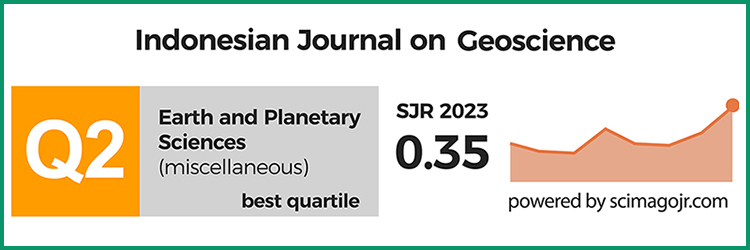Hydrocarbon Source Rock Potential of the Sinamar Formation, Muara Bungo, Jambi
DOI:
https://doi.org/10.17014/ijog.1.1.53-64Keywords:
Sinamar Formation, Oligocene, organic petrography, biomarker, shaleAbstract
The Oligocene Sinamar Formation consists of shale, claystone, mudstone, sandstone, conglomeratic sandstone, and intercalation of coal seams. The objective of study was to identify the hydrocarbon source rock potential of the Sinamar Formation based on geochemichal characteristics. The analyses were focused on fine sediments of the Sinamar Formation comprising shale, claystone, and mudstone. Primary data collected from the Sinamar Formation well and outcrops were analyzed according to TOC, pyrolisis analysis, and gas chromatography - mass spectometry of normal alkanes that include isoprenoids and sterane. The TOC value indicates a very well category. Based on TOC versus Pyrolysis Yields (PY) diagram, the shales of Sinamar Formation are included into oil prone source rock potential with good to excellent categories. Fine sediments of the Sinamar Formation tend to produce oil and gas originated from kerogen types I and III. The shales tend to generate oil than claystone and mudstone and therefore they are included into a potential source rock.
References
Bemmelen, van R.W., 1949. The Geology of Indonesia. Vol. I A, The Hague. Netherlands, pp.
De Coster, G.L., 1974. The Geology of the Central and South Sumatera Basins. Proceedings of Indonesian Petroleum Assosiation 3th Annual Convention, p.77-110.
Hermiyanto, M.H., 2010. Karakteristik Batuan Sedimen Halus Formasi Sinamar Untuk Mengetahui Potensinya Sebagai Batuan Induk Di Daerah Muara Bungo, Jambi. Thesis, Unpublished, Institut of Teknologi Bandung, 49pp.
Pulunggono, A. Agus Haryo, S., and Kosuma, C.G., 1992. Pre-Tertiary and Tertiary Fault System As a Framework of the South Sumatra Basin: A strudy of SAR MAPS, Proceedings of Indonesian Petroleum Association, 21st Annual Convention, Jakarta, p.339-360.
Rosidi, H.M.D., S. Tjokrosapoetro, B. Pendowo, S. Gafoer, and Suharsono, 1996. Peta Geologi Lembar Painan dan Bagian Timur Laut Lembar Muarasiberut, Sumatra, skala 1:250.000. Pusat Penelitian dan Pengembangan Geologi, Bandung.
Silitonga, P.H. and Kastowo, 1995. Peta Geologi Lembar Solok skala 1:250.000. Pusat Penelitian dan Pengembangan Geologi, Bandung.
Suwarna, N., Budhitrisna, T., Santosa, S., and Mangga S.A., 1994. Peta Geologi Lembar Rengat skala 1:250.000. Pusat Penelitian dan Pengembangan Geologi, Bandung.
Waples, D.W., 1985. Geochemistry in Petroleum Exploration. International Human Resources Development Corporation, Boston.
doi:10.1007/978-94-009-5436-6
Waples, D.W. and Machihara, T., 1991. Biomarkers for geologists a practical guide to the application of steranes and triterpanes in petroleum geology, American Association of Petroleum Geologists Methods in Exploration Series 9. The American Association of Petroleum Geologists, Tulsa, Oklahoma, USA. DOI:10.1017/S0016756800008529
Zajuli, M.H.H. and Panggabean, H., 2013. Depositional Environment of Fine-Grained Sedimentary Rocks of the Sinamar Formation, Muara Bungo, Jambi. Indonesian Journal of Geology, 8 (1), p.25-38. doi:10.17014/ijog.v8i1.153



















